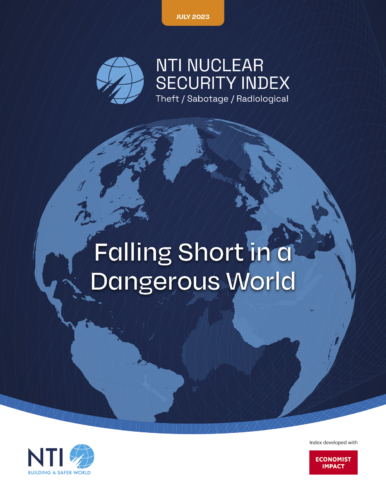The NTI Index is recognized as the premier resource and tool for evaluating global nuclear and radiological security across 175 countries and Taiwan. Developed by the Nuclear Threat Initiative (NTI) and Economist Impact (EI) in 2012, the NTI Index uses publicly available information to track progress and recommend actions for governments, regulators, international institutions, industry, and civil society to take to better protect nuclear and radioactive materials and nuclear facilities around the world.
The Nuclear Security Index
Nuclear facilities face an array of risks from terrorists, new disruptive technologies, and climate change–related events, to military assaults during war, such as those on the Zaporizhzhia Nuclear Power Plant in Ukraine. In an uncertain world, the Nuclear Security Index provides a centralized accounting of the complex global nuclear security architecture in an effort to drive continued progress, highlight evolutions in best practices and priorities, and illuminate emerging risks and challenges.
What is the Nuclear Security Index?
The Nuclear Security Index comprises three dynamic and comprehensive rankings that assess nuclear security conditions across 175 countries and Taiwan:
1. Theft: Secure Materials
This ranking assesses the 22 countries with 1 kilogram or more of weapons-usable nuclear materials (highly enriched uranium or separated plutonium) and the policies, actions, and other factors related to securing those materials against the risk of theft.
2. Theft: Support Global Efforts
This ranking assesses the 154 countries and Taiwan with less than 1 kilogram of or no weapons-usable nuclear materials and the policies, actions, and other factors related to their support for global nuclear security efforts.
3. Sabotage: Protect Facilities
This ranking assesses the 46 countries and Taiwan with nuclear facilities where sabotage could result in a dangerous release of radiation and the policies, actions, and other factors related to protecting nuclear facilities against the risk of sabotage.
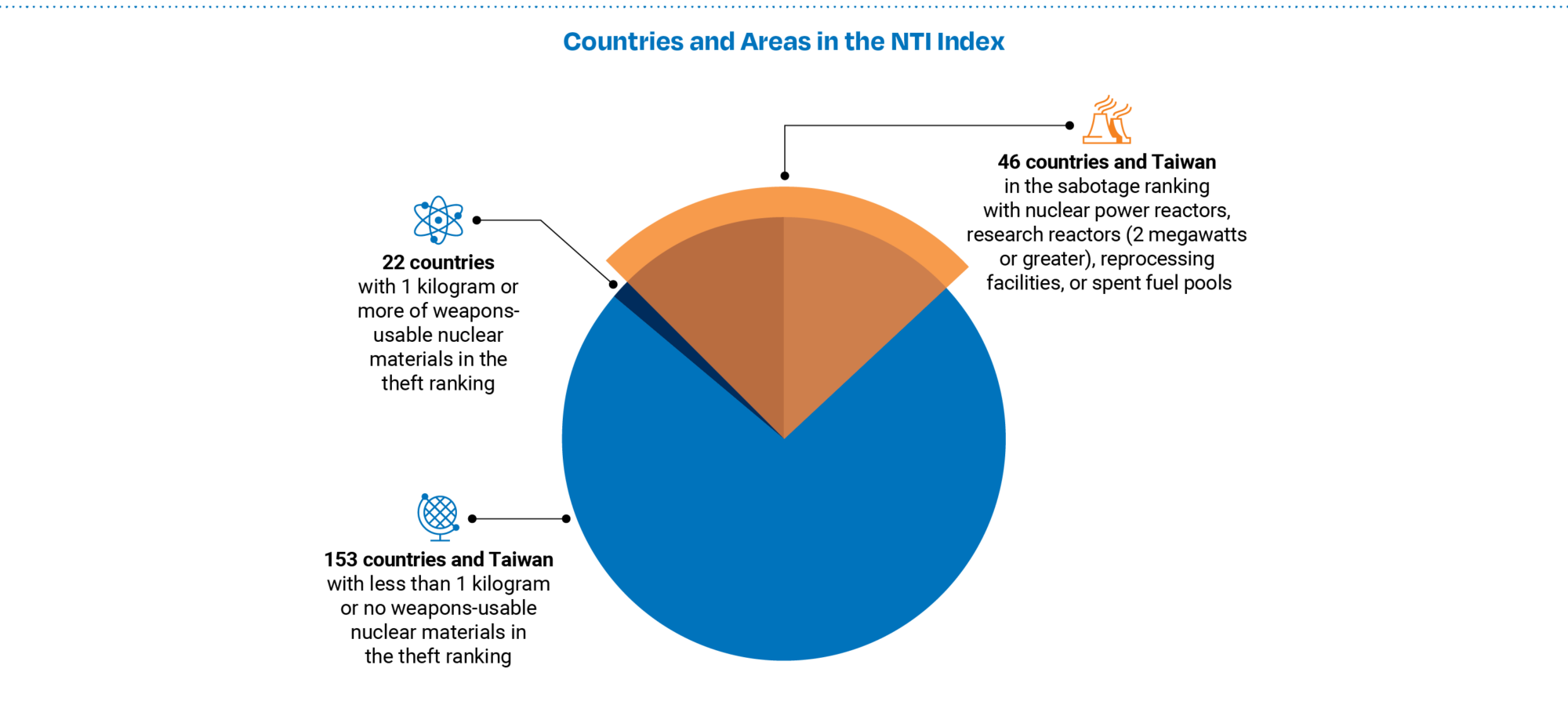
What Goes into the Rankings?
The Nuclear Security Index is backed by a robust and time-tested methodology, available in its entirety here.
EI conducts the research for the Nuclear Security Index using publicly available information, including primary legal texts and legal reports; government and academic publications and reports; websites of government authorities, international organizations, and non-governmental organizations; interviews with experts; and local and international news media reports.
After researching and gathering data, NTI and EI provide the opportunity for the 49 countries and areas with weapons-usable nuclear materials, nuclear facilities, or both to review and comment on the preliminary results as part of the data confirmation process. Twenty-six of these 49 countries and areas participated in the data confirmation process for the 2023 Index. By consulting governments during the process, the Nuclear Security Index can report accurate and current information in a transparent way.
In addition to consulting governments, NTI and EI also convene a panel of highly respected nuclear security experts with a broad range of expertise from countries around the world. The panel’s input helps ensure that the Index reflects an international point of view and ongoing international discussions about nuclear security priorities.
-
The International Panel of Experts
How are Countries and Areas Scored?
Countries and areas earn scores on a scale of 0 to 100, where 100 is the highest possible score. Weights are applied to categories and indicators to reflect relative priorities. Each ranking is built from of a framework of five categories where each category consists of indicators and subindicators. A country or area’s overall score is the weighted sum of its category scores; its category scores are the weighted sum of its indicator scores within that category; and its indicator scores are the sum of its subindicator scores.
The five categories are:
1. Quantities and Sites
- This category captures the quantity of weapons-usable nuclear materials, the number of civil nuclear sites, and the frequency of transport of weapons-usable nuclear materials in a particular country—all factors related to the risk of weapons-usable nuclear materials being stolen. It also includes a trend indicator as to whether a country is increasing or decreasing its overall quantities of weapons-usable nuclear materials.
- It is used in the Theft: Secure Materials framework. The Sabotage: Protect Facilities framework includes this category, but it only considers the number of civil nuclear sites, not quantities of nuclear materials.
2. Security and Control Measures
- This category encompasses the core activities directly related to protection and accounting of nuclear materials: physical protection, control and accounting, insider threat prevention, security during transport, response capabilities, cybersecurity, and security culture.
- It is used in the Theft: Secure Materials framework and the Sabotage: Protect Facilities framework.
3. Global Norms
- This category includes actions that contribute to the strengthening of global norms for nuclear materials security. It captures important international legal commitments like treaty ratification, voluntary participation in a number of global initiatives, international assurances, and International Atomic Energy Agency (IAEA) nuclear security information circulars.
- It is included in all three ranking frameworks.
4. Domestic Commitments and Capacity
- This category includes actions that indicate how well a country or area has implemented its international commitments and its capacity to do so. This category includes the extent of United Nations Security Council Resolution 1540 implementation, the status of legislation to implement the amended Convention on the Physical Protection of Nuclear Material, and the presence of an independent regulatory body.
- It is included in all three ranking frameworks.
5. Risk Environment
- This category includes contextual factors, such as political stability, effective governance, corruption, and illicit activities by non-state actors, that can affect a country or area’s ability to implement effective security and regulatory oversight.
- It is included in all three ranking frameworks.
The categories, indicators, and subindicators combine to create three distinct rankings:
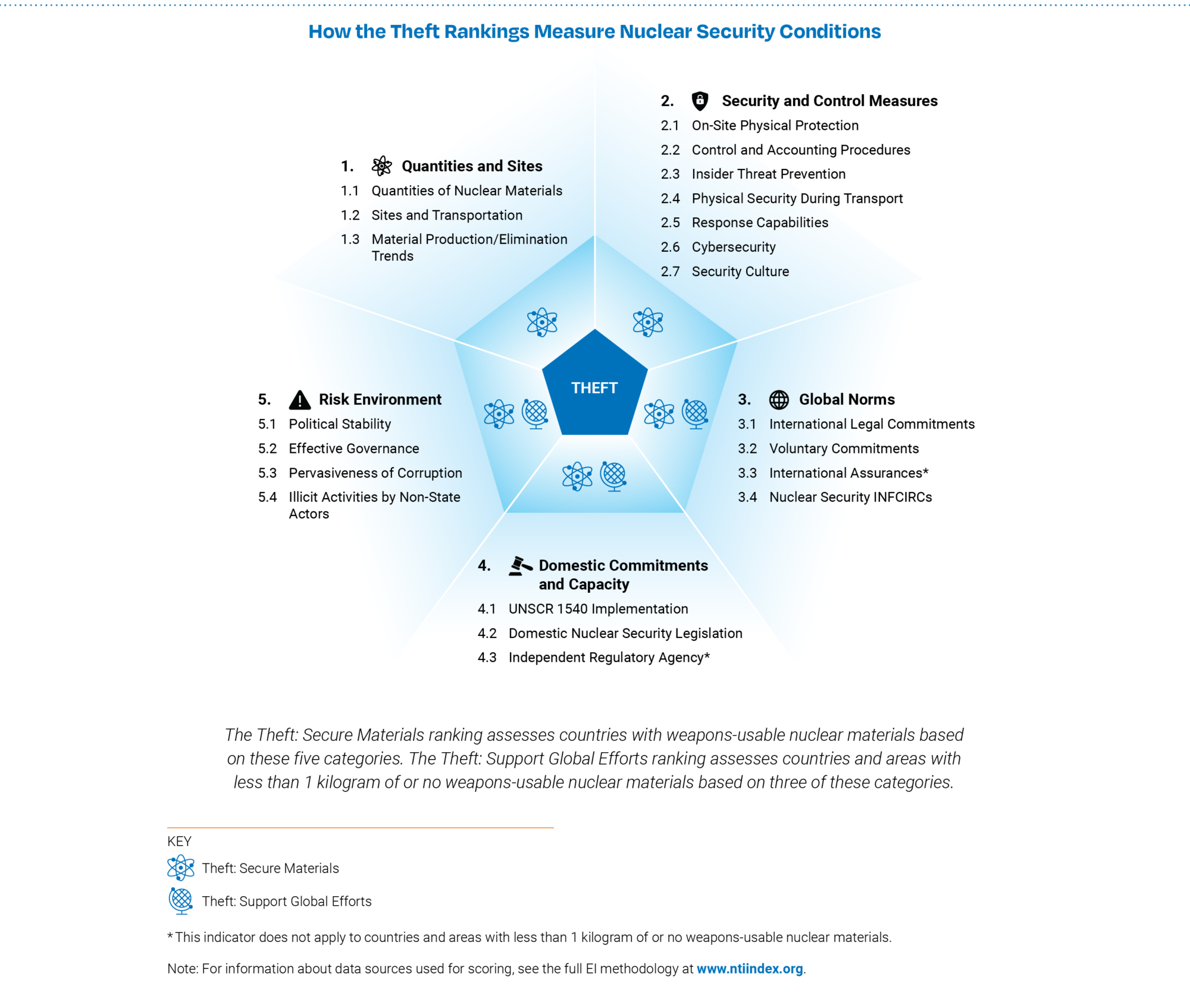
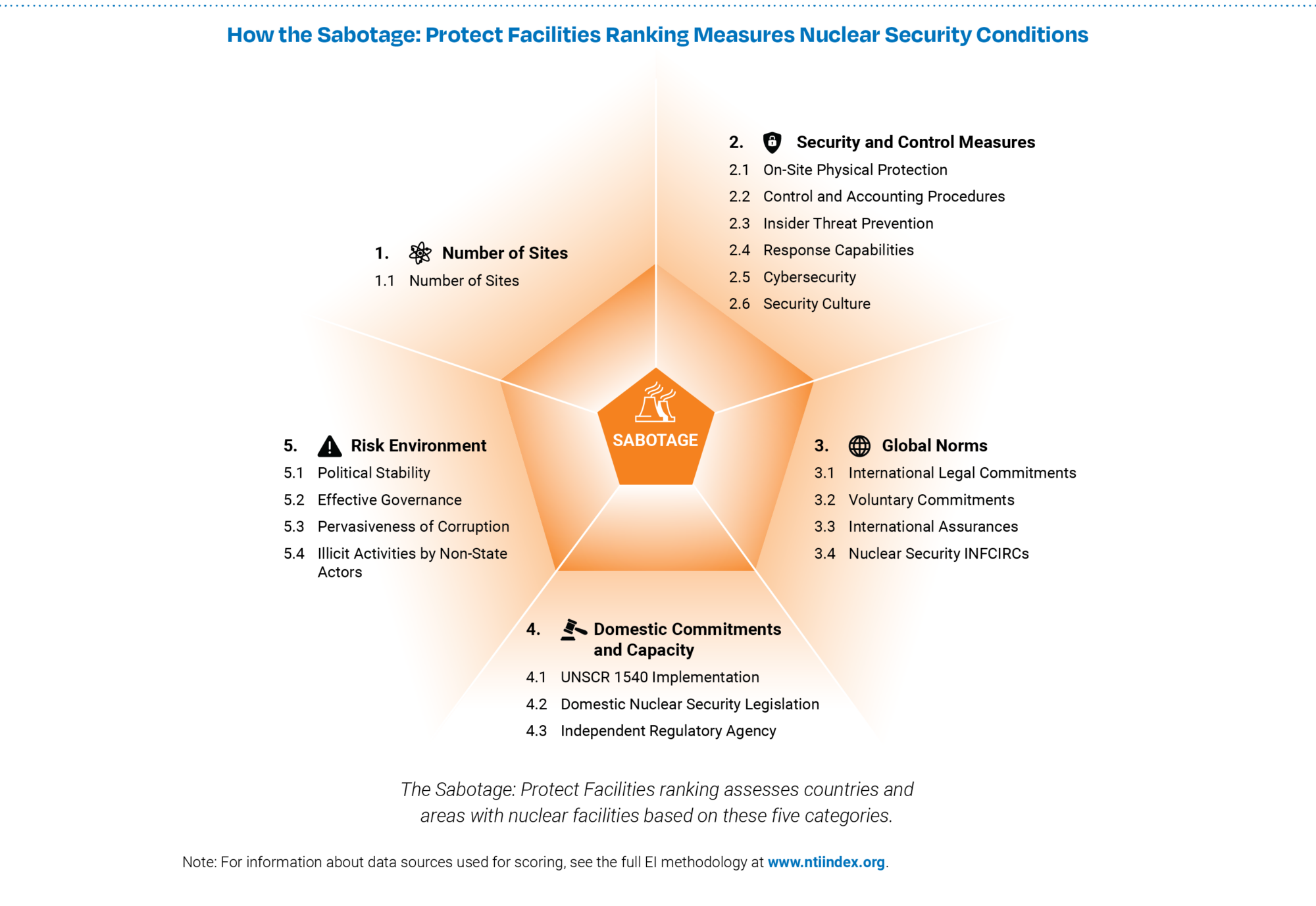
The Radiological Source Security Assessment
Radioactive sources are used in a wide range of settings—from hospitals to oil fields and agricultural facilities—in almost every country and Taiwan. Although they cannot be used to fuel a nuclear weapon, radioactive sources can be used to build a radiological dispersal device (often called a dirty bomb or a radiation exposure device) which requires less technical sophistication to build than a nuclear weapon but is still capable of inflicting widespread panic, environmental contamination, and significant social, economic, and financial costs.
Radiological security has suffered from a lack of political attention in recent years, leaving many radioactive sources more vulnerable to theft than weapons-usable nuclear materials. For these reasons, terrorist organizations have repeatedly pursued and even built dirty bombs.
In this context, the Radioactive Source Security Assessment evaluates national policies, commitments, and actions to secure radioactive sources and prevent a dirty bomb in 175 countries and Taiwan. The assessment includes a country or area’s adherence to relevant laws and regulations, support for global norms, commitment and capacity to replacing high-activity radioactive sources with alternative technology, and the risk environment.
Unlike the Nuclear Security Index, the assessment does not score or rank countries and areas. Together, however, the data provide insight into the governance and security of radioactive sources, serve to reinforce global norms, and provide a foundation for future in-depth analysis.
What Goes into the Assessment?
The Radioactive Source Security Assessment has its own detailed methodology, available in full here.
The Radioactive Source Security Assessment relies on publicly available information from existing databases or other consolidated resources, including publications and reports from the IAEA, other international organizations, and academia; national statements at multilateral events; data collected by government authorities, international organizations, and non-governmental organizations; EI proprietary country reports; and interviews with experts.
Limited information is available on radiological security worldwide. For a limited set of indicators, a result of “No” represents either a negative response to the question or that no data were available.
How are Countries and Areas Assessed?
Similar to the Nuclear Security Index, the Radioactive Source Security Assessment comprises four categories of indicators and subindicators. Rather than scoring and ranking countries and areas on their performance in each category, the assessment only collates the data collected. The categories are:
A. National Measures
- This category assesses a country or area’s domestic policies, commitments, and actions for managing and securing radioactive sources.
B. Global Norms
- This category assesses a country or area’s international commitments and support for global norms around radioactive sources, such as the IAEA Code of Conduct on the Safety and Security of Radioactive Sources and its supplemental guidance.
C. Commitment and Capacity to Adopt Alternative Technologies
- This category assesses a country or area’s commitment to supporting the development and implementation of alternative technology to high-activity radioactive sources, and their capacity to sustainably implement alternative technologies to high-activity radioactive sources.
D. Risk Environment
- This category assesses a country or area’s risk environment.
The categories, indicators, and subindicators combine to create the assessment:
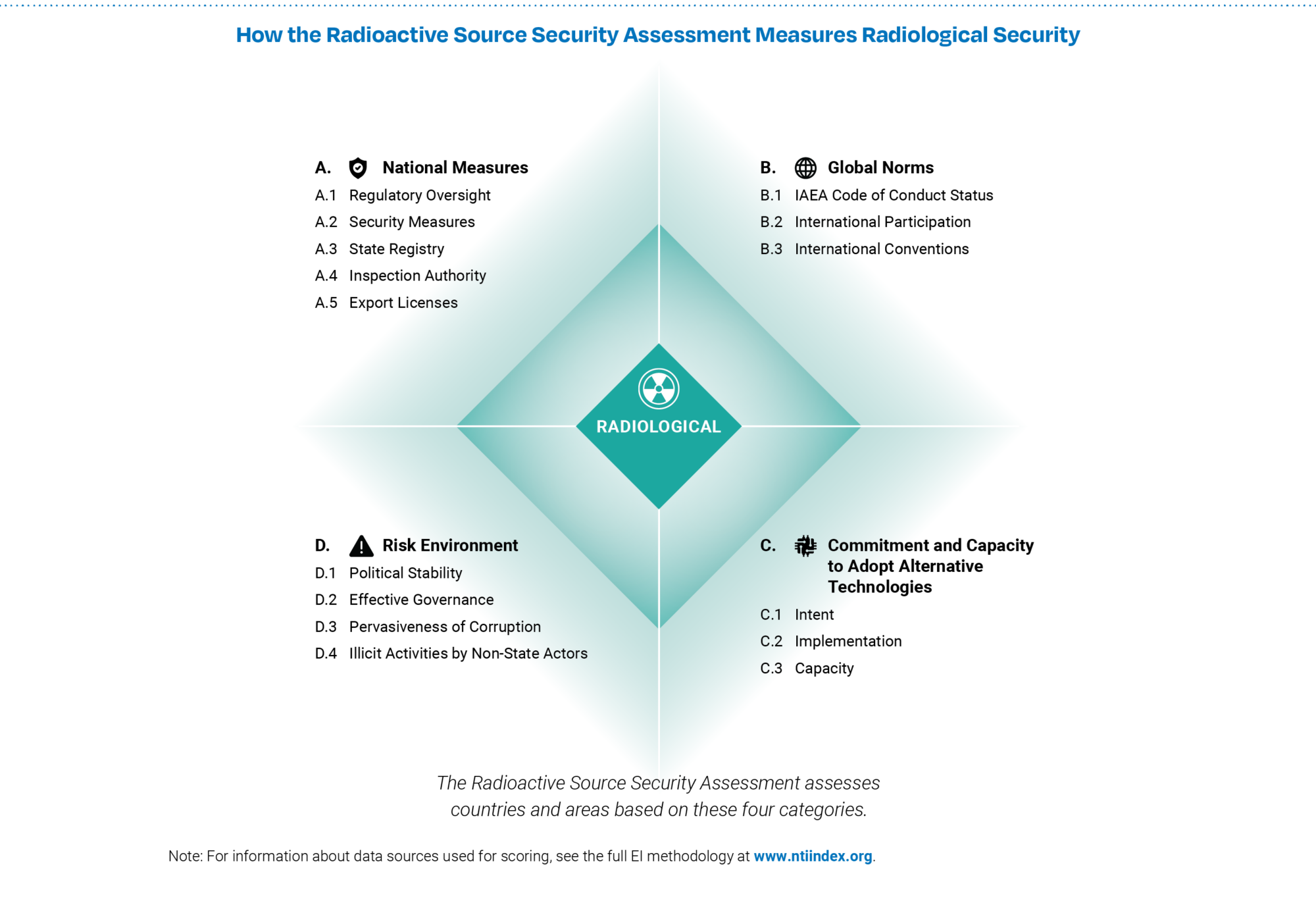
The Team
Scott Roecker
Vice President for Nuclear Materials Security, NTI
Nickolas Roth
Senior Director for Nuclear Materials Security, NTI
Ross Matzkin-Bridger
Senior Director for Nuclear Materials Security, NTI
Jack Brosnan
Program Officer for Nuclear Materials Security, NTI

